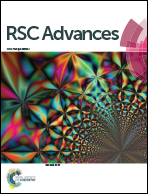Selective recognition of hydrogen sulfide using template and catalyst free grown ZnO nanorods†
Abstract
Hydrogen sulfide is an important endogenous signaling molecule which can play a key role in regulating blood pressure, cardiovascular and age-associated diseases. But it is extremely toxic if inhaled and can even cause death at higher concentrations. This work reports a systematic investigation of template and catalyst free grown ZnO nanorods through simple chemical spray pyrolysis technique and their room temperature hydrogen sulfide sensing characteristics such as sensitivity, selectivity, stability, response and recovery times. The structural, morphological, optical and electrical properties of ZnO nanostructures were investigated using X-ray diffractometer (XRD), field emission scanning electron microscope (FE-SEM), UV-Vis spectrophotometer and electrometer respectively. The role of density of nanorods formed on the glass substrates through spray cycle modulation has been used as an effective tool for achieving better sensing response. ZnO nanorods with the diameter ranging from 200–250 nm exhibited high selectivity towards hydrogen sulfide and the mechanism has been reported. The challenge of selectivity has also been solved efficiently through ZnO nanorods.



 Please wait while we load your content...
Please wait while we load your content...